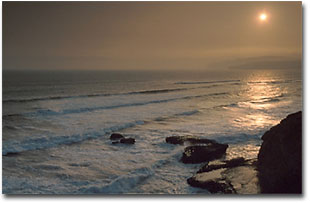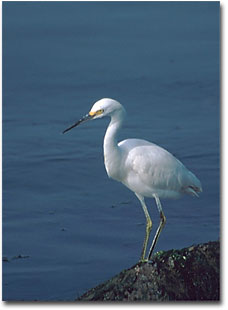 The Paracas National Reserve, consisting of the Paracas Peninsula and the Ballestas Islands (or "Baby Galapagos"), is the only nature reserve on the Peruvian coast. The Reserve is located about 145 miles south of Lima, Perú's capital, and can be reached by bus or car via the Pan American Highway. The bus ride from Lima takes approximately 4 hours, and travels through the country's coastal desert, a surreal landscape of windswept dunes.
The Paracas National Reserve, consisting of the Paracas Peninsula and the Ballestas Islands (or "Baby Galapagos"), is the only nature reserve on the Peruvian coast. The Reserve is located about 145 miles south of Lima, Perú's capital, and can be reached by bus or car via the Pan American Highway. The bus ride from Lima takes approximately 4 hours, and travels through the country's coastal desert, a surreal landscape of windswept dunes.
The Paracas Peninsula, easily reached by taxi from either Paracas or Pisco (as in Pisco Sour), is a great place for landscape work. A number of overlooks are located 100 ft. or more above the Pacific Ocean, making them ideal locations for wide angle sunset shots that include rocks and surf below. There are also a number of rock arches and other formations worthy of your photographic eye. My favorite, La Catedral (The Cathedral), is a naturally-formed arch straddling the beach far below. The compositional opportunities for this formation alone are almost endless. If time (and the authorities) permit, hike down to the beach for an eye-level view of this massive rock arch. Los Frailes (The Friars), a large rock spire reaching upwards from the water, is another formation worth a visit in the Paracas Peninsula.
If you would like to photograph wildlife while on the peninsula, head for the Visitor Center and museum, located about one mile from the park's entrance. About a 2 mile easy walk from the center, is a colony of flamingos that can be viewed from a wooden lookout tower. Unfortunately, the flamingos are a couple hundred yards from the overlook, and passage past this point is prohibited. You will need at least a 600mm lens to photograph these colorful and exotic birds.
The Ballestas Islands can only be reached by boat, also from either Paracas or Pisco. No matter where you leave from, the first boats leave at 8:00am and the trip lasts one hour. On the way to the Ballestas, the boat will stop briefly to view El Candelabro, a giant, candelabrum-shaped drawing etched on the sand hills overlooking the Bay of Paracas. No one knows who made the figure or what it means, but some scientists theorize it represents the constellation of the Southern Cross; others think it is a stylized drawing of a cactus, a symbol of power to the Chavín, a local pre-Inca culture.
Actual time spent at the Ballestas is about 40 minutes. Because of conservation concerns, tourists are not allowed on the islands. This means you have to anticipate your needs and be photographically prepared when you step on that boat (more on this later).
 Thanks to the Humboldt Current, a deep upwelling of cold, nutrient-rich water sweeping northward along the Peruvian coast, the Ballestas Islands support an abundant and varied population of sea and bird life. During your tour of the islands, you will spot sea lions (called lobos de mar in Spanish, or "wolves of the sea"), perhaps porpoises frolicking near the boat, and plenty of bird life including Peruvian Boobies, Inca Terns, cormorants, pelicans, and if you are lucky, Humboldt Penguins (a rarity this far north). Long lenses in the 300mm-500mm range should do the trick while photographing around the islands.
Thanks to the Humboldt Current, a deep upwelling of cold, nutrient-rich water sweeping northward along the Peruvian coast, the Ballestas Islands support an abundant and varied population of sea and bird life. During your tour of the islands, you will spot sea lions (called lobos de mar in Spanish, or "wolves of the sea"), perhaps porpoises frolicking near the boat, and plenty of bird life including Peruvian Boobies, Inca Terns, cormorants, pelicans, and if you are lucky, Humboldt Penguins (a rarity this far north). Long lenses in the 300mm-500mm range should do the trick while photographing around the islands.
Shooting from a moving boat with long lenses can be challenging under the best of conditions, and the waters can get rough as the boat gets closer to the vertical, rocky wall faces of the islands. Therefore, make sure you bring fast film, open up your lens, and use stabilizing lenses (IS for Canon, VR for Nikon) if you have them. Also, bring an extra camera body if possible so you can keep shooting while your helper (your significant other?) puts more film in the spent camera. Remember to keep shooting, and don't forget to look for landscape compositions of frothy water crashing against the natural arches, spires and walls of these eerie-looking islands.
As for your camera gear, make sure you have something to wipe off the ocean spray that is sure to land on it. I use a soft chamois cloth for this purpose, but any towel will do. I also keep my camera strap around my neck in anticipation of the boat's sudden lurches. Bring more film than you think you will need. Shooting around the islands takes the term "spray and pray" to new levels. Also, pack extra batteries; they are expensive and sometimes hard to find in this part of the world. And don't forget to wipe down all your gear when you return to terra firma.
Although challenging, I found shooting under these conditions to be exhilarating. If you have time, consider going on the boat trip more than once. This will increase your chances of returning home with some great photographs, and at the very least you will have a thrilling ride on the oceans of Southern Peru.
Admittedly, photographing in the Paracas National Reserve can be difficult compared to your local national park. However, the opportunity to bring home beautiful and unique images of this area makes any inconvenience worthwhile.
The best hotel in the area is the Hotel Paracas, a full-service operation complete with its own dock, fleet of boats, restaurant and bar, pools, and other amenities. The rooms, simple but clean, are located in bungalows spread among the hotel's beautifully landscaped grounds. In fact, shooting the colorful flora around the hotel grounds is in itself a rewarding photo opportunity. A double costs about $75.00. The hotel can arrange your boat trip to the Islas Ballestas, a taxi ride to the Paracas Peninsula, or even your bus trip from Lima. Visit www.hotelparacas.com for more information. A number of other hotels, restaurants, and boat services are also located in nearby Pisco.
About the images...
- Sunset - Canon EOS 3, Canon 28-70 mm f2.8L USM lens, warming filter, Gitzo tripod, 1/30th sec. @ f11, Velvia rated normally.
- Snowy Egret - Canon EOS 3, Canon 75-300 mm IS USM lens, coupled with Kenko 1.4x tele-extender, hand-held, 1/1000th sec. @ f4.5, Kodak EK 200 pushed to ISO 400.
Editor's Note - Efraín M. Padró resides in Denver, Colorado and operates a part-time freelance writing/photography business called Padró Images. Be sure to visit his web site at www.padroimages.com.
Comments on this article? Send them to the editor.

